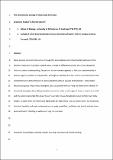Files in this item
The evolutionary ecology of decorating behaviour
Item metadata
| dc.contributor.author | Ruxton, Graeme D. | |
| dc.contributor.author | Stevens, Martin | |
| dc.date.accessioned | 2016-06-02T23:32:47Z | |
| dc.date.available | 2016-06-02T23:32:47Z | |
| dc.date.issued | 2015-06 | |
| dc.identifier | 207340615 | |
| dc.identifier | c590f2e5-378d-4544-8330-4201e23049dc | |
| dc.identifier | 000357685300021 | |
| dc.identifier | 84930510956 | |
| dc.identifier | 000357685300021 | |
| dc.identifier.citation | Ruxton , G D & Stevens , M 2015 , ' The evolutionary ecology of decorating behaviour ' , Biology Letters , vol. 11 , no. 6 , 20150325 . https://doi.org/10.1098/rsbl.2015.0325 | en |
| dc.identifier.issn | 1744-9561 | |
| dc.identifier.uri | https://hdl.handle.net/10023/8923 | |
| dc.description.abstract | Many animals decorate themselves through the accumulation of environmental material on their exterior. Decoration has been studied across a range of different taxa, but there are substantial limits to current understanding. Decoration in non-humans appears to function predominantly in defence against predators and parasites, although an adaptive function is often assumed rather than comprehensively demonstrated. It seems predominantly an aquatic phenomenon-presumably because buoyancy helps reduce energetic costs associated with carrying the decorative material. In terrestrial examples, decorating is relatively common in the larval stages of insects. Insects are small and thus able to generate the power to carry a greater mass of material relative to their own body weight. In adult forms, the need to be lightweight for flight probably rules out decoration. We emphasize that both benefits and costs to decoration are rarely quantified, and that costs should include those associated with collecting as well as carrying the material. | |
| dc.format.extent | 5 | |
| dc.format.extent | 432846 | |
| dc.language.iso | eng | |
| dc.relation.ispartof | Biology Letters | en |
| dc.subject | Camouflage | en |
| dc.subject | Covering | en |
| dc.subject | Crypsis | en |
| dc.subject | Masking | en |
| dc.subject | Ornamenting | en |
| dc.subject | Shield carrying | en |
| dc.subject | QH301 Biology | en |
| dc.subject.lcc | QH301 | en |
| dc.title | The evolutionary ecology of decorating behaviour | en |
| dc.type | Journal item | en |
| dc.contributor.institution | University of St Andrews. School of Biology | en |
| dc.contributor.institution | University of St Andrews. Centre for Biological Diversity | en |
| dc.identifier.doi | 10.1098/rsbl.2015.0325 | |
| dc.description.status | Peer reviewed | en |
| dc.date.embargoedUntil | 2016-06-03 |
This item appears in the following Collection(s)
Items in the St Andrews Research Repository are protected by copyright, with all rights reserved, unless otherwise indicated.

